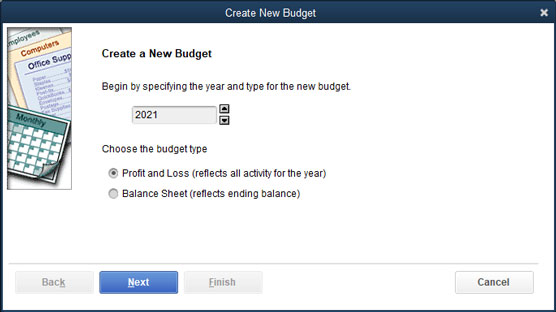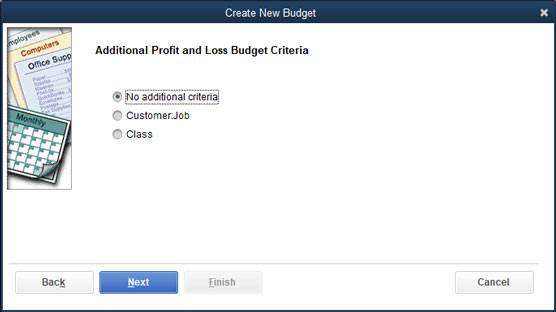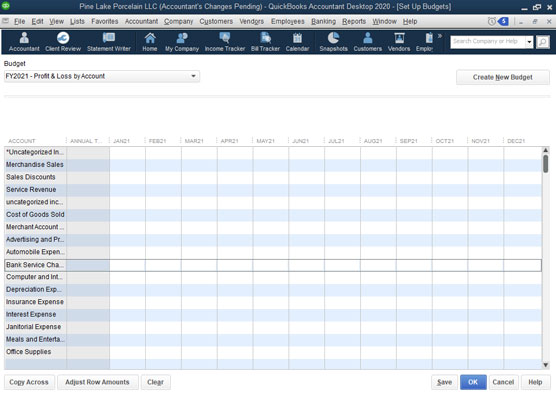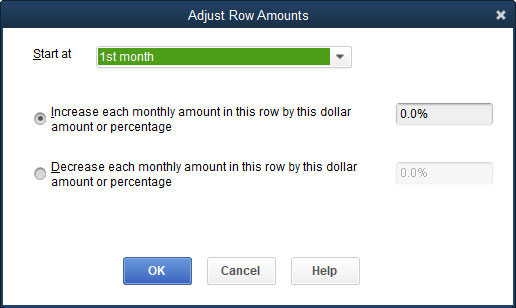1. Choose Company→Planning and Budgeting→Set Up Budgets.
QuickBooks opens the Create New Budget dialog box, shown in the following figure, which you use to create a new budget. (Bet you wouldn’t have guessed that.)
Note: If you’ve previously set up a budget, QuickBooks displays the Set Up Budgets window rather than the Create New Budget dialog box. If QuickBooks displays the Set Up Budgets window, you need to click its Create New Budget button to display the Create New Budget dialog box.
 The Create New Budget dialog box
The Create New Budget dialog box2. Select the fiscal-year period.
Identify the fiscal year you’re budgeting for. To do that, enter the fiscal year in the provided text box. If you’re budgeting for fiscal year 2021, for example, use the buttons to change the year to 2021.
3. Choose whether to create a profit and loss or balance sheet budget.To create a profit and loss budget, select the Profit and Loss radio button, click Next, and proceed to Step 4. To create a balance sheet budget, select the Balance Sheet radio button, click Finish, and skip to Step 5.
Note that you use a different approach for profit and loss budgets and balance sheet budgets. For profit and loss budgets, you budget the amount of revenue or expense expected for the account for the month. For balance sheet budgets, you budget the ending account balance: the ending account balance expected for the asset, liability, or owner’s equity account at month’s end.
4. In the Additional Profit and Loss Budget Criteria dialog box (see the following figure), specify additional profit and loss budget criteria, and click Next.If you chose to create a profit and loss budget in Step 3, select the Customer:Job radio button to further extend your budget to include Job details; select the Class radio button to include classes in your budget; or simply select the No Additional Criteria radio button.
Note: To budget by class, you must first turn on class tracking.
 The Additional Profit and Loss Budget Criteria selections
The Additional Profit and Loss Budget Criteria selections5. In the Create New Budget dialog box (see the following figure), choose whether to create the budget from scratch or previous data.
To create a budget from scratch and start with a clean slate, select the Create Budget from Scratch radio button. To create a budget based on your actual data from last year, select the radio button titled Create Budget from Previous Year’s Actual Data.
 Choosing whether to create a budget from scratch
Choosing whether to create a budget from scratch6. Click Finish when you’re done.
QuickBooks displays the Set Up Budgets window.
 The Set Up Budgets window
The Set Up Budgets windowHow to work with an existing budget
To edit an existing budget in QuickBooks, follow these steps:1. Choose Company→Planning & Budgeting→Set Up Budgets.
QuickBooks displays the Set Up Budgets window. You use this window to record the amount that you expect for each revenue and expense for each month during the year in which you’re budgeting.
2. Select a budget, or create a new one.Choose the budget you want to work with from the Budget drop-down list at the top of the window. To create a new budget (you can have as many budgets as you want), click the Create New Budget button. For help with creating a new budget, see the preceding section.
3. (Optional) Choose a customer.You typically budget by account. If you want to budget in finer detail by also estimating amounts for customers, jobs, or classes, you can use the Current Customer:Job drop-down list to identify specific customers from whom you expect revenue or for whom you expend costs.
Note: The Customer:Job drop-down list box doesn’t appear unless, when you created the budget you’re now working with, you indicated that you wanted to budget by customer.
4. Record the budgeted amounts for each month of the fiscal year.Type the amounts you want to budget for each account in the appropriate month columns. Again, remember that revenue and expense accounts are budgeted as the amount expected for the month. Asset, liability, and owner’s equity amounts are budgeted as the ending account balance expected for the month.
To copy the budgeted amount for one month into the text boxes for the succeeding months, click the Copy Across button.
5. (Optional) Adjust row amounts.If you find that the yearly total for an account isn’t what you want it to be, you can go back and change the amounts for each month so that they add up to the correct total, or you can click the Adjust Row Amounts button. Clicking this button displays the Adjust Row Amounts dialog box, shown in the following figure. Use the Start At drop-down list to choose the month you want to start with (either the first month or the currently selected month). Then choose whether you want to increase or decrease the amounts budgeted, and by how much (by entering a dollar amount or a percentage). Click OK when you finish; QuickBooks closes the dialog box.
 The Adjust Row Amounts dialog box
The Adjust Row Amounts dialog box6. Repeat as necessary.
Repeat Steps 3 through 5 for each of the accounts for which you want to record budgeted amounts.
Yes, I know, this is a lot of work. Just so you know, in large companies with hundreds or thousands of employees, two or three people spend much of or even all of their year working with the budgeted data.





